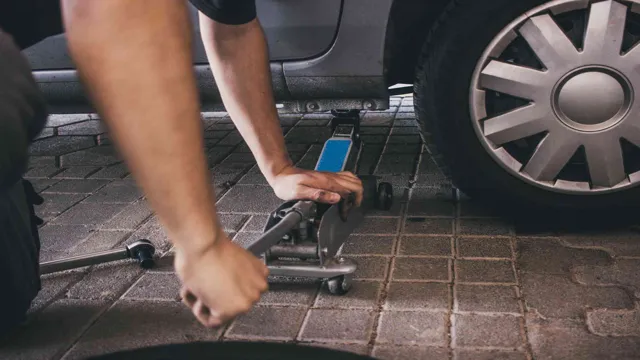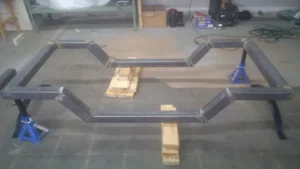If you’ve ever had to change your car’s oil, rotate your tires, or perform any other maintenance that requires lifting your car off the ground, you know how important it is to use jack stands. Jack stands provide a stable and secure base for your car, keeping it safely elevated while you work underneath. However, improperly putting a car on jack stands can be dangerous, and it’s important to know the correct technique to ensure your safety.
Think of it like building a house – you wouldn’t want to start construction on an unstable foundation, and the same goes for lifting your car. Jack stands are the foundation of your work, so taking the time to properly set them up can save you from a potentially hazardous situation. In this blog post, we’ll walk you through the step-by-step process of putting a car on jack stands.
We’ll cover everything from choosing the right type and size of jack stands to placing them in the correct location under your car. With our tips and tricks, you can rest easy knowing that your car is securely lifted and you’re able to work safely underneath.
Safety First
When it comes to getting under your car, safety should always be your top priority. Putting your car on jack stands can be a bit daunting, but with the right technique, it can be done safely. First, make sure you have the right type of jack stands for your vehicle and that your vehicle is parked on a flat, level surface.
Next, find the designated jack points on your car, usually located near the wheels. Once you’ve found those spots, use your hydraulic jack to lift your car by the frame, then place the jack stands beneath the designated jack points. Make sure the jack stands are securely in place before releasing the hydraulic jack and getting under your car.
Remember, using jack stands incorrectly can be extremely dangerous, so take your time, and always err on the side of caution. Properly putting a car on jack stands is a skill every car owner should know to prevent injury or damage to themselves, their vehicle, and their property.
Check Your Work Area
When it comes to starting a new project, it’s essential to check your work area to ensure that you’re safe. Always remember that safety comes first and that any negligence or oversight can lead to serious accidents. So before you dive into your work, take some time to assess the overall area and look for any potential hazards that might be present.
Don’t forget to check for any open wires or electrical equipment, as well as any flammable objects or substances nearby. If you’re working with sharp tools or heavy machinery, make sure you’re wearing the appropriate protective gear and that your work area is properly secured to avoid slipping or falling. So, take a few extra minutes to run through your safety checklist before you begin, and you’ll be on your way to a safe and successful project.
Remember, it only takes one accident to change everything, so prioritize safety every time you work.

Have the Right Tools
When it comes to tackling any task, particularly those involving tools and equipment, safety should always be the top priority. Having the right tools for the job is crucial, but it’s just as important to ensure that you’re equipped with the necessary safety gear. This includes wearing gloves, safety glasses, ear protection, and a hard hat, among other things.
Before starting any project, take the time to inspect your tools and make sure they’re in good working order, and be sure to read instructions carefully and follow them closely. Remember, accidents can happen even with the most experienced DIYers, so it’s important to take every precaution possible to protect yourself and others around you. Investing in quality tools and equipment, along with the proper safety gear, is essential for any DIY enthusiast or professional.
By doing so, you’re not only safeguarding your well-being, but you’re also ensuring that you’ll be able to complete the task at hand safely and efficiently.
Wear Protective Gear
When it comes to engaging in any activity, safety must come first. It doesn’t matter if it’s playing sports, working construction, or riding a bike; wearing protective gear is essential to prevent injuries. Protective gear such as helmets, kneepads, and elbow pads can provide an added layer of protection to your body.
You don’t have to be a professional to wear them; even beginners can benefit from them. For instance, if you’re planning to cycle, wearing a helmet can save your life in case of an accident. The same goes for other activities like skateboarding, skiing, or rollerblading.
It’s better to be safe than sorry. Not wearing protective gear not only puts oneself in danger but others as well. Parents should encourage their children to wear protective gear from a young age so that it becomes a habit.
In conclusion, always make sure to wear protective gear whenever you engage in any kind of activity to stay safe and prevent injuries.
Positioning the Jack Stands
If you’re curious about how to properly put a car on jack stands, we’ve got you covered. First and foremost, safety is of the utmost importance when it comes to vehicle maintenance. Begin by parking the car on a level surface and engaging the emergency brake.
Next, use a floor jack to lift the vehicle at the specified jacking points. Once the car is elevated, slide the jack stands underneath on either side of the vehicle, placing them on the appropriate spots. Lower the car onto the stands until it is resting securely.
Double-check that the stands are stable and level before crawling underneath the car to perform any maintenance. Remember, never work under a car that is simply supported by a jack – always rely on properly positioned jack stands to keep you safe.
Find the Right Location
When positioning the jack stands, finding the right location is critical. Before getting started, it’s essential to ensure that the ground is stable and level. Never position the jack stands on dirt or grass, as they can sink into the soil and cause the vehicle to tip over.
Use a sturdy surface such as concrete or asphalt for optimal support. Additionally, verify that the car is on a flat surface and in park or in gear with the parking brake engaged. Once you’ve determined the appropriate location, place the jack under the vehicle’s jacking point and raise it just high enough to position the jack stands beneath it.
Position the jack stands correctly and securely, ensuring they’re firmly in place before lowering the jack and resting the car securely on the stands. Regularly check that the stands are stable and that the vehicle is securely positioned before proceeding with any work to avoid any potential mishaps.
Use a Level Surface
When it comes to raising your vehicle with jack stands, it is essential to position them correctly for your safety. Firstly, find a level surface to park your vehicle on and ensure that the handbrake is engaged. Even a subtle incline can interfere with the stability of the jack stands as they could tilt, resulting in a catastrophic accident.
Secondly, identify the lifting points of your vehicle, which are specially marked by the manufacturer to provide safe lifting with a jack stand, typically found under the car’s chassis. Place the stands on a sturdy base surface and adjust the height to ensure that the weight is adequately distributed. Finally, give the vehicle a slight push to ensure that it’s secure before crawling underneath it.
Taking the time to ensure that the jack stands are level and secure can prevent any fatal accidents from happening. So, before you begin to work under your car, position the stand in the correct location and breathe easy knowing that you are working in a safe and secure environment.
Identify the Jack Points
When it comes to positioning your jack stands, it is essential to identify the jack points of your vehicle correctly. These jack points are the designated areas where the jack can safely lift the car without damaging the frame or body. Usually, these points can be found in the owner’s manual or on a sticker located near the car’s jacking location.
Once you’ve located these points, position your jack stands securely, making sure they are level and snug against the car’s frame. You don’t want them to slip or fall while you’re working underneath the vehicle. Remember to always use caution and follow safety precautions to prevent accidents from occurring.
With the right positioning and adequate support, you can confidently work on your vehicle and get the job done right.
Place the Jack Stands Carefully
When it comes to working under your car, safety should always come first. Jack stands are indispensable tools that provide stability and ensure that you can conduct repairs or maintenance with ease. Nonetheless, you need to place the jack stands carefully to prevent accidents and protect yourself.
Before lifting your vehicle, make sure that you select a safe spot to place the stands, and then use a hydraulic jack to elevate it. Once it’s at a suitable height, put the jack stands firmly underneath it, positioning them under the vehicle’s frame or designated jacking points. Remember to place them alongside each other to prevent accidental slips.
It’s also critical to verify that the jack stands are securely locked in place, which ensures they can hold the weight of the vehicle. Always remember that safety is paramount, and if you have any doubts at any point, stop and re-evaluate your placement of the jack stands.
Lifting the Car Safely
If you need to get underneath your car for maintenance or repairs, it’s crucial to know how to properly put a car on jack stands to avoid accidents. First, park your car on a flat, even surface and engage the parking brake. Use a jack to lift the corner of the car where you want to place the stand.
Once the car is lifted, slide the jack stand underneath the car’s designated jacking point and adjust its height accordingly. Double-check that the stand is securely in place before slowly lowering the jack until the weight of the car is resting on the stand. Repeat the process for the other side of the car.
Always use jack stands that have a weight capacity that exceeds the weight of your vehicle. Remember, lifting a car can be dangerous and potentially fatal, so take your time and ensure that everything is properly secured before getting underneath.
Use the Right Jack
When it comes to lifting a car, you want to make sure you’re doing it safely and correctly. One of the most important things you can do is use the right jack for the job. There are a few different types of jacks out there, but not all of them are suitable for lifting a car.
For example, don’t try to use a bottle jack (the kind that looks like a small barrel) to lift a car, as they can be unstable and aren’t meant for the job. Instead, opt for a floor jack, which is designed specifically for lifting cars. Make sure the jack is rated for the weight of your car, too.
If you’re unsure what the weight of your car is, you can usually find it in your owner’s manual or by doing a quick online search. Using a jack that isn’t rated for the weight of your car can be dangerous and potentially result in the car falling off the jack. Lastly, when you’re using a jack to lift your car, make sure you’re doing it on a flat surface.
Trying to jack up your car on uneven ground can also be unsafe and cause the car to shift or fall off the jack. Taking the time to use the right jack and lift your car safely can help prevent accidents and make your job easier in the long run.
Locate the Jack Point
When lifting your car for maintenance or repair, it is crucial to locate the jack point to ensure that you lift the car safely. The jack point is the designated area on the car where the jack should be placed to lift the car without damaging it. This area is usually marked with a notch or a triangle on the side of the car’s frame.
However, if you can’t locate it, the owner’s manual usually has a diagram showing the exact location of the point. Before lifting the car, make sure that the point is clean and in good condition to avoid any slips or accidents. Additionally, make sure to use a jack that can handle the weight of your car and always use jack stands to secure the car in place.
Taking these precautions will help you lift your car safely and avoid costly or dangerous accidents. Remember, safety always comes first!
Lift the Car Slowly
When it comes to lifting a car, safety should be your top priority. One of the most critical tips to remember is to lift the car slowly. Rushing the process can result in accidents and injuries, which can be fatal.
Take your time and ensure that the car is securely in place before attempting to lift it. It’s also essential to have the right equipment, such as jack stands and a floor jack, to lift the car safely. Make sure to read the manufacturer’s instructions before proceeding to use such equipment.
When lifting the car, ensure that you place the jack stands and floor jack in the right spots. It’s best to avoid using makeshift items such as wooden blocks, as they can be unstable and lead to accidents. Remember always to have someone with you when lifting a car, as this provides an extra layer of safety.
By lifting the car slowly and securely, you can avoid accidents and injuries and get the job done safely and efficiently.
Double Check Your Placement
When lifting a car, it’s important to double-check your placement to ensure safe and proper lifting. Before you start, inspect the car’s jack points and make sure they are sturdy and suitable for lifting. Never attempt to lift a car in an unstable or unsafe environment, as this can lead to accidents.
Once you’ve identified the correct jack points, position the jack properly underneath the car and ensure that it is centered and stable. Make sure the wheels are chocked and the emergency brake is engaged to prevent the car from rolling or moving during the lifting process. It’s essential to follow these steps to avoid any potential mishaps while lifting your car.
Remember, safety should always come first when it comes to car maintenance.
Lowering the Car Properly
Putting a car on jack stands is an essential skill that every car enthusiast should have. Lowering the car properly is crucial to ensure your safety and the safety of your vehicle. Before you begin, ensure that the car is parked on a flat surface and that the handbrake is engaged.
Jack up the car using a hydraulic jack and place the jack stands under the designated jack points. Lower the car onto the stands and ensure that they are securely in place. Check the car’s stability by giving it a gentle push before working on it.
It’s also essential to use chocks to prevent the car from rolling. Don’t forget to lift the car evenly, and never place jack stands under the suspension arms or other unstable parts of your vehicle. Remember to follow these steps carefully to avoid any mishaps and ensure a smooth and safe lifting of your car.
Remove the Jack Stands
Now that you’ve successfully completed your car repairs, it’s time to remove the jack stands and safely lower the car. Removing the jack stands is a crucial part of the process, and you want to make sure you do it properly. Start by double-checking that all the nuts and bolts are tight and secure.
Then, slowly lower the jack until the wheels make contact with the ground. It’s important to be patient and take your time during this step, as rushing could lead to damage to your car or even worse, personal injury. Once the car is back on the ground, remove the jack stands carefully and avoid putting any parts of your body under the car.
With a little bit of patience and attention to detail, you can safely lower your car and be ready to hit the road again. Remember, safety always comes first when working on your vehicle!
Lower the Car Evenly
Lowering a car can be a fun project, but it’s important to do it properly to avoid damaging your vehicle or making it unsafe to drive. One crucial aspect of lowering your car is to do it evenly. Lowering one side more than the other can cause the vehicle to become unbalanced, leading to problems with handling, steering, and suspension.
To lower your car evenly, it’s important to measure the distance from the ground to the fender on each corner of the vehicle and make adjustments accordingly. It’s important to remember that lowering your car too much can also cause problems, so it’s always best to consult with a professional or do plenty of research before making any modifications to your vehicle. With proper planning and execution, lowering your car can improve its appearance and performance, as long as it’s done safely and evenly.
Check for Stability
Lowering your car can be a great way to improve its look and handling. But it’s important to do it properly to prevent any stability issues. One key factor in lowering a car is making sure it’s done evenly on all sides.
A car that’s lower on one side than the other can create problems with stability during turns or sudden lane changes. It’s also important to choose the right suspension components for your car. Lowering springs or coilovers can help keep your car stable and reduce body roll.
However, if you’re going for an extreme drop, you may need to install additional components like adjustable sway bars and camber kits to maintain proper alignment and prevent excessive tire wear. Overall, lowering your car can be a great way to improve its appearance and performance, but it’s important to do it carefully and with attention to detail for optimal stability.
Conclusion
In conclusion, putting a car on jack stands is a task that requires patience, caution, and a keen eye for detail. It’s not just about lifting the car and placing the stands – it’s important to check for stability, level ground, and a sturdy support system. You don’t want to end up like the famous nursery rhyme character Humpty Dumpty, whose fragile foundation led to a catastrophic crash.
So, remember to take your time, follow the instructions, and always prioritize safety. With these tips in mind, you’ll be putting your car on jack stands like a pro in no time!”
FAQs
What are the safety precautions to take before putting a car on jack stands?
Always use jack stands on a flat, level surface. Make sure to chock the wheels that remain on the ground and engage the parking brake. Do not place any part of your body under the vehicle.
Can I rely on the car jack alone without using jack stands?
No, you should never rely on the car jack alone. Always use jack stands as a safety measure to support the vehicle while you work underneath.
How do I properly position the jack stands under the car?
Always use the manufacturer-recommended jack point and place the stand directly underneath. Do not place the stand on an uneven or soft surface.
Can I jack up both sides of the car at the same time?
No, you should only jack up one side of the car at a time to avoid destabilizing the vehicle.
What type of jack stands should I use for my car?
You should use jack stands that are rated for your car’s weight and height. Always use jack stands that have a locking mechanism or pin to secure the stand in place.
How do I properly lower the car from the jack stands?
Use the jack to slowly lower the vehicle onto the ground. Make sure to remove the jack stands from under the car before driving.
Can I use wooden blocks as jack stands?
No, you should use only properly rated jack stands that are designed to support the weight of your vehicle. Wooden blocks can splinter or break under the weight of the car, putting you at risk.






